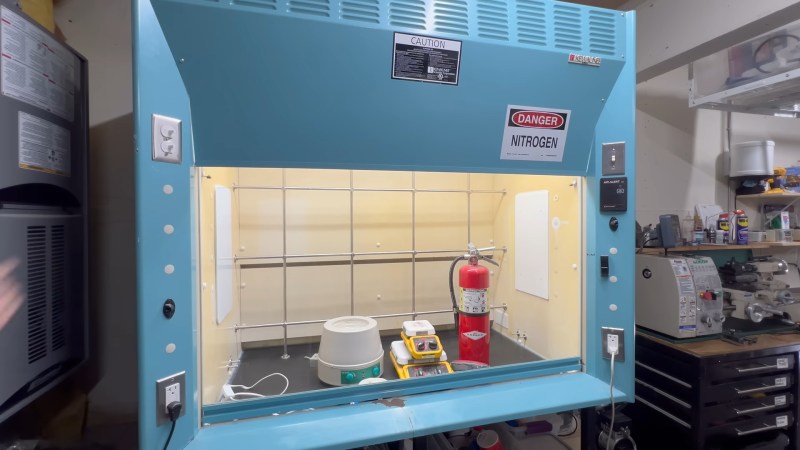Semiconductor fabrication is complicated requiring nasty chemicals for everything from dopants to etchants. Working with such chemicals at home is dangerous and after releasing hydrochloride acid fumes into his lab, [ProjectsInFlight] decided the time was right to get one for a mere $200.
I can hear the readers down in the comments already saying, “why not just make one?” But a properly engineered fume hood provides laminar flow which absolutely ensures no leakage of fumes out of the hood. However, such proper engineering comes with an impressive price tag, so the used market was the only choice. This is less dangerous then it sounds as companies are required by both OSHA and the EPA to clean their fume hoods before removal, so no chemical residue should remain after purchase.
After inspecting a more expensive unit, [ProjectsInFlight] bought a smaller unit destined for the scrap heap. Very little work was required to get it actually working. Some LED lighting and cleaning got the machine in a workable condition. A neatly welded table was built for the hood with an acrylic painted plywood work surface. While professional fume hoods use solid epoxy work tops, these are expensive, and polyurethane should be fine. A high flow rate fan neatly tied up the fume hood restoration.
However, merely having a fume hood is not enough for some. Therefore, [ProjectsInFlight] turned to his lathe to create a lab rack. This device is a kind of ladder looking thing which provides numerous mounting points for clamps making chemistry easier and safer. Some careful and somewhat sketchy machining resulted in a professional looking lab rack for a fraction of the professional price tag. The whole project was neatly tied up with machined chilled water and vacuum inlet ports.
This is not the first time [ProjectsInFlight] has made the pages of Hackaday. Make sure to check out the fume hood’s inspiration in this gold nonparticipant fabrication hack!
















“This is less dangerous then it sounds as companies are required by both OSHA and the EPA to clean their fume hoods before removal, so no chemical residue should remain after purchase.”
As a chemist and purveyor of used equipment from labs…. this is hilarious.
Fume hoods are not required to have laminar airflow. They are designed for personnel safety by containing hazardous fumes, while a laminar flow hood is used in a sterile, particle-free environment in conjunction with HEPA filters. While laminar airflow is optional in some fume hoods to minimize turbulence and leakage, the primary principle of a fume hood is negative pressure and a consistent inward flow of air to remove contaminants from the user’s breathing space.
Sorry, that was meant to be a separate post, not a reply.
Ooh! Stories, please. What’s the nastiest thing you’ve ever (at least tentatively) identified on something like that?
You know, I’m not particularly worried that I couldn’t build a fume hood that reliably extracted vapor from pretty much anywhere in its volume. I’d probably run some simulations before actually putting it together. But it would definitely be worth $200 to not have to start from scratch.
What I have trouble figuring out how to do is to build a hood, especially with a useful sash, that will fit under my ceiling.
I work as an HVAC tech at a three building industrial complex. The company I work for makes slurries and pads for polishing semiconductor wafers. I’m responsible for certifying the lab hoods semi-annually. There are several ways to certify a hood. I use a flow meter and take readings at six locations in the hood. I record the readings at the six locations and average the readings. They should be a minimum of sixty cubic feet per inute of air flow to pass and 100 cubic feet per minute of airflow is better. There is also a smoke test that can be done to ensure equal airflow throughout the hood. The one thing that we use which does the most damage to the hoods is hydroflouric acid (HFA). The ventilation fans on the roof are made of aluminium and the HFA slowly dissolves the body and impeller of the fans. The hood in the video is in very good shape and looks fantastic especially for $200.
I have a colleague that has done a lot of industrial engineering in his career. He built two fume hoods for conformal coating utilizing mainly Creform tubing and laser cut MDF. Total cost of each fume hood was about $240 (connected to an existing exhaust system mounted on the roof) They were designed to perfectly fit the space where they sit and match the other equipment perfectly. They have both been reviewed by OSHA reps and Certified Industrial Safety Engineers. No issues, always praised for how well they work. They have been in daily service for 11 years now.
I don’t understand the “Danger Nitrogen” sign at the fume hood in the photo. Really curious where this fume hood was originally. Unless you have a large enough amount of compressed or liquid nitrogen in that same room that would create an oxygen-deficient atmosphere and cause asphyxiation if suddenly vented fully, there is no “danger” of the presence of Nitrogen. The air we breathe is 78% Nitrogen.
Chemist humor.
I’ll have an H2O.
I’ll have an H2O too.
Second chemist died.
Bartender was also a chemist.